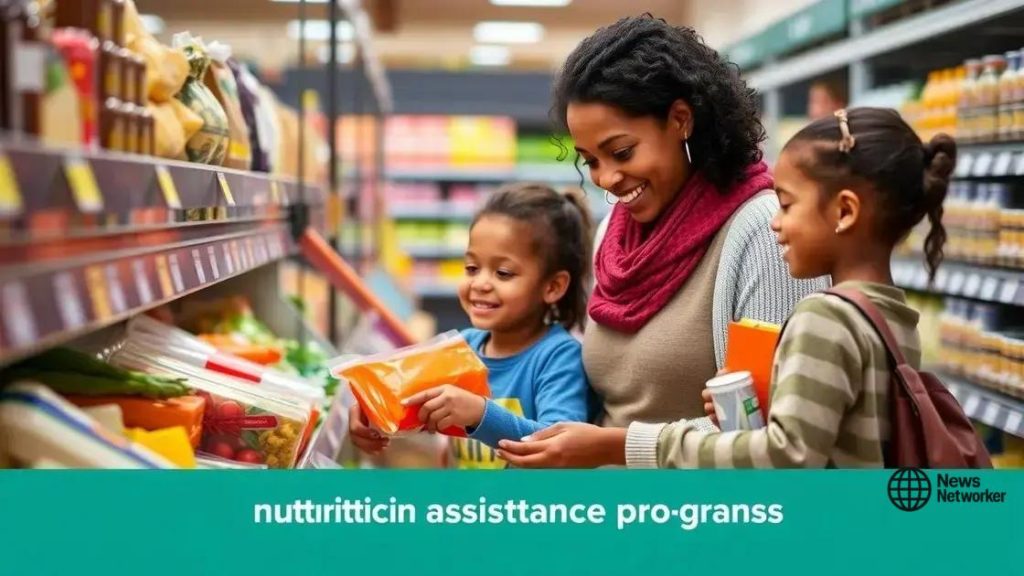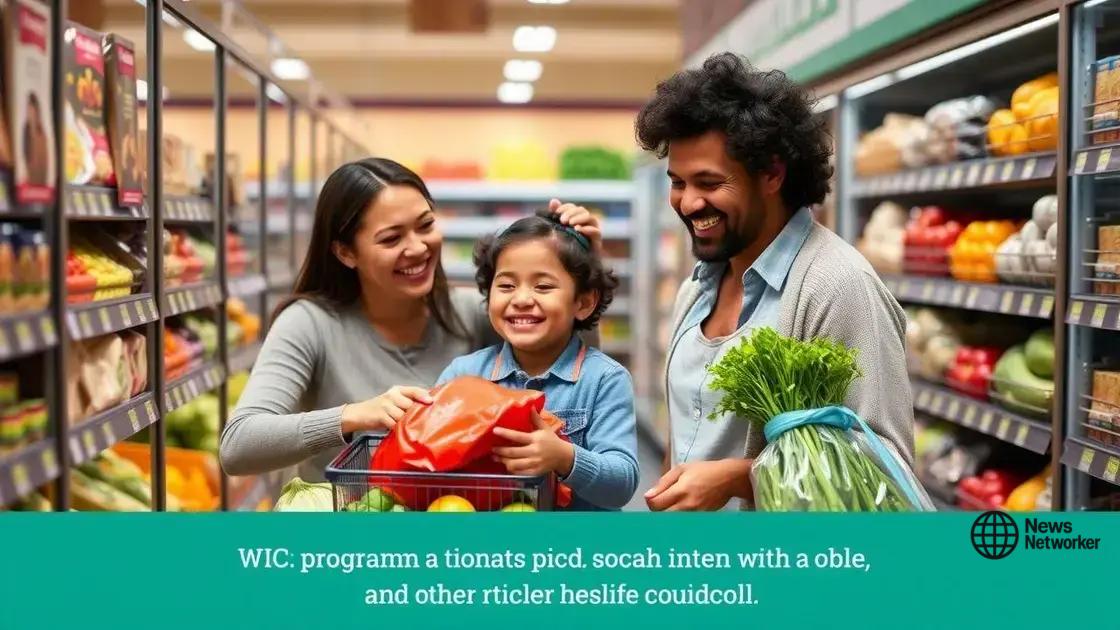WIC modernization legislation: what you need to know

The WIC modernization legislation improves nutritional assistance by enhancing access to healthy foods, providing educational resources, and expanding technology use, effectively supporting families in need.
WIC modernization legislation is making waves in how nutrition assistance is delivered across communities. As programs evolve, it’s important to understand how these changes can affect families and the support they receive. Let’s dive into what these updates really mean for you.
Understanding WIC modernization legislation
The WIC modernization legislation plays a crucial role in enhancing the nutrition programs for women, infants, and children. It aims to update how these programs operate, ultimately improving access to essential resources and support for communities in need. This legislation seeks to streamline the application process, making it easier for eligible families to benefit from nutritious foods.
Key Features of WIC Modernization
The recent updates introduced by the WIC modernization legislation include various important aspects. Enhancements focus on reaching more families and ensuring they receive assistance effectively. Additionally, these changes aim to adapt to the modern needs of participants.
- Increased access to online services for applying and managing benefits
- Expanded food options that promote diverse and healthy eating
- Improved outreach efforts to educate families about available resources
As the benefits of this legislation unfold, many families experience a more streamlined process. This positively affects their ability to acquire healthy foods and nutrition education. Moreover, the modernization tackles barriers that previously hindered access to the program, such as lengthy paperwork and restrictive eligibility requirements.
Impact on Communities
The ripple effects of the WIC modernization legislation extend to local communities as well. By providing better resources and services, communities can witness improved health outcomes. These enhancements create a supportive environment where families feel empowered to make healthier choices and access vital assistance.
Furthermore, community organizations can also benefit. Increased collaboration with WIC programs enables them to offer more comprehensive support, ensuring families receive all necessary services. As the modernization initiative continues to evolve, its impacts can pave the way for a more effective nutritional assistance landscape.
Key changes in the WIC program
Recent updates to the WIC program have introduced significant changes aimed at better serving families in need. These adjustments focus on streamlining processes, improving access to resources, and addressing the diverse needs of participants. The intention behind these changes is to enhance the support that families receive, making it more efficient and user-friendly.
Expanded Eligibility
One of the most noteworthy changes in the WIC program is the expansion of eligibility criteria. This allows more families to qualify for assistance. By adjusting financial thresholds and including additional support for specific groups, such as breastfeeding women and working families, the program aims to reach those who need help the most.
- Higher income limits to accommodate more families
- Inclusion of fathers and guardians in the application process
- Enhanced support for non-English speakers
These reforms help ensure that families, regardless of their circumstances, can access the nutritious foods that WIC offers. This also reflects a growing recognition of the variety of family structures and the importance of providing resources to all caregivers.
Increased Food Options
The WIC program is also adapting to nutritional advancements by including a wider variety of food options. This change encourages participants to adopt healthier eating habits and makes it easier for families to choose options that fit their dietary preferences.
By embracing local food systems, the program now emphasizes fresh fruits, vegetables, whole grains, and other nutritious foods. This not only meets the nutritional needs of participants but also supports local farmers and businesses.
Improved Technology Integration
Another key change is the integration of technology into the WIC program. Through online platforms and mobile applications, families can now manage their benefits more easily. This advancement means less time spent on paperwork and more time focused on health and nutrition.
Features such as virtual appointments and online grocery ordering provide convenience and accessibility. Participants can now receive guidance from nutritionists and access resources remotely, reducing barriers to support and assistance.
Benefits for families receiving WIC

Receiving assistance from the WIC program provides numerous benefits for families. These advantages go beyond just financial support; they promote better health, nutrition, and overall well-being for women, infants, and children.
Access to Nutritious Foods
One of the primary benefits families gain from WIC is access to healthy foods. Eligible participants receive vouchers that can be used to purchase a variety of nutritious items, including fruits, vegetables, whole grains, and dairy products. This helps ensure that children get the essential nutrients they need to grow and thrive.
- Improved dietary choices for children and parents
- Encourages consumption of fresh produce
- Availability of breastfeeding supplies and education
These food benefits are crucial for maintaining a healthy diet, especially during critical developmental stages for children. By providing these resources, WIC supports families in making healthier lifestyle choices.
Nutritional Education and Support
Alongside food benefits, WIC also offers nutritional education. Participants receive guidance on meal planning, understanding food labels, and making healthier choices within their budget. This knowledge empowers families to prepare delicious, nutritious meals that suit their lifestyles.
Understanding proper nutrition can lead to long-term health benefits. WIC staff often organize workshops and group counseling sessions, allowing families to learn from each other and share experiences. These programs also encourage a sense of community among participants.
Healthcare Access
Another significant advantage of the WIC program is its connection to healthcare services. WIC encourages regular health check-ups for pregnant women and young children, which can identify potential health issues early. This proactive approach helps in safeguarding the health of mothers and their children.
Participants are often referred to healthcare providers for additional services. This can include immunizations, developmental assessments, and mental health support. By expanding access to healthcare resources, WIC aims to create a more comprehensive safety net for families in need.
Challenges faced during modernization
Modernizing the WIC program comes with several challenges that must be addressed to ensure its success. These obstacles can hinder the effectiveness of the program and affect families relying on its support. Understanding these challenges is vital for stakeholders involved in the program’s implementation and improvement.
Technology Implementation
One significant challenge is integrating new technology into existing systems. Updating software and creating user-friendly platforms require substantial investment and training. Many families may not have access to the internet or smartphones, which can limit their ability to utilize new features.
- Need for training for both staff and participants
- Potential gaps in access for low-income families
- Continuous maintenance and updates required to keep systems effective
This technological shift can create frustration for some users, as they adapt to new ways of managing their benefits. To mitigate these issues, WIC needs to plan adequate training sessions and support materials for all users.
Policy and Funding Limitations
Another challenge is navigating the complex landscape of policy and funding. Changes in legislation can affect how funds are allocated to the WIC program. Without stable funding, programs may struggle to implement necessary updates or maintain current services.
Additionally, shifts in political priorities can impact the long-term sustainability of modernization efforts. Advocating for continuous support and funding is essential to overcome these hurdles.
Community Outreach and Education
Lastly, educating communities about the changes in the WIC program presents its own set of challenges. Many families may not be aware of new benefits or do not understand how to access them. Effective outreach is crucial for ensuring that those eligible for support can take full advantage of the modernizations.
Outreach efforts must be tailored to reach diverse populations, including non-English speakers and those in rural areas. Building trusted relationships within communities can help spread awareness and encourage participation.
Future of WIC and nutrition assistance
The future of WIC and nutrition assistance looks promising as the program adapts to meet evolving community needs. As awareness of nutrition and health expands, WIC programs are increasingly focused on enhancing participant experience and outreach.
Emphasis on Health Outcomes
Future initiatives aim to improve health outcomes for families by incorporating more comprehensive nutritional education. Workshops and resources will provide families with knowledge about meal planning, budgeting, and the importance of balanced diets.
- Greater access to nutritional workshops
- Use of technology for virtual health education
- Focus on preventative health measures
By emphasizing health, WIC can help families make informed choices that last a lifetime, ultimately reducing healthcare costs for both individuals and the program overall.
Collaborations and Partnerships
Collaboration with local organizations and community leaders is another key aspect of the future direction of the WIC program. By working together with schools, healthcare providers, and food banks, WIC can extend its reach and impact.
These partnerships foster a network of support that enhances food security and encourages healthy lifestyles. Community programs can also play a role in encouraging participation in WIC services, bringing more families into the fold.
Technology and Innovation
Technology will continue to play a vital role in the transformation of WIC and nutrition assistance. Enhancements in app development and online services aim to streamline eligibility checks and benefit distribution.
As more families embrace technology, WIC can utilize mobile platforms for better communication and service delivery. The goal is to make the program more accessible and user-friendly, ensuring that families can easily connect to the resources they need.
Conclusion: The ongoing modernization of the WIC program is a vital step toward enhancing support for families across the country. As communities adapt to changes in technology and nutrition, the program’s commitment to improving access to healthy foods, education, and healthcare remains strong. By addressing challenges while focusing on future innovations, WIC can better serve families. Collaboration, education, and outreach will ensure that families receive the assistance they need for a healthier future together.
FAQ – Frequently Asked Questions about WIC and Nutrition Assistance
What are the main benefits of the WIC program?
The WIC program offers nutritious food, education on healthy eating, and access to healthcare services for women, infants, and children.
How does WIC modernization improve access for families?
WIC modernization enhances access through technology, making it easier for families to apply for benefits and manage their nutrition needs.
What challenges are faced during the WIC modernization process?
Challenges include implementing new technology, navigating policy changes, and ensuring effective community outreach.
How does WIC support health education for families?
WIC provides workshops and resources that educate families about nutrition, meal planning, and how to maintain a healthy lifestyle.





